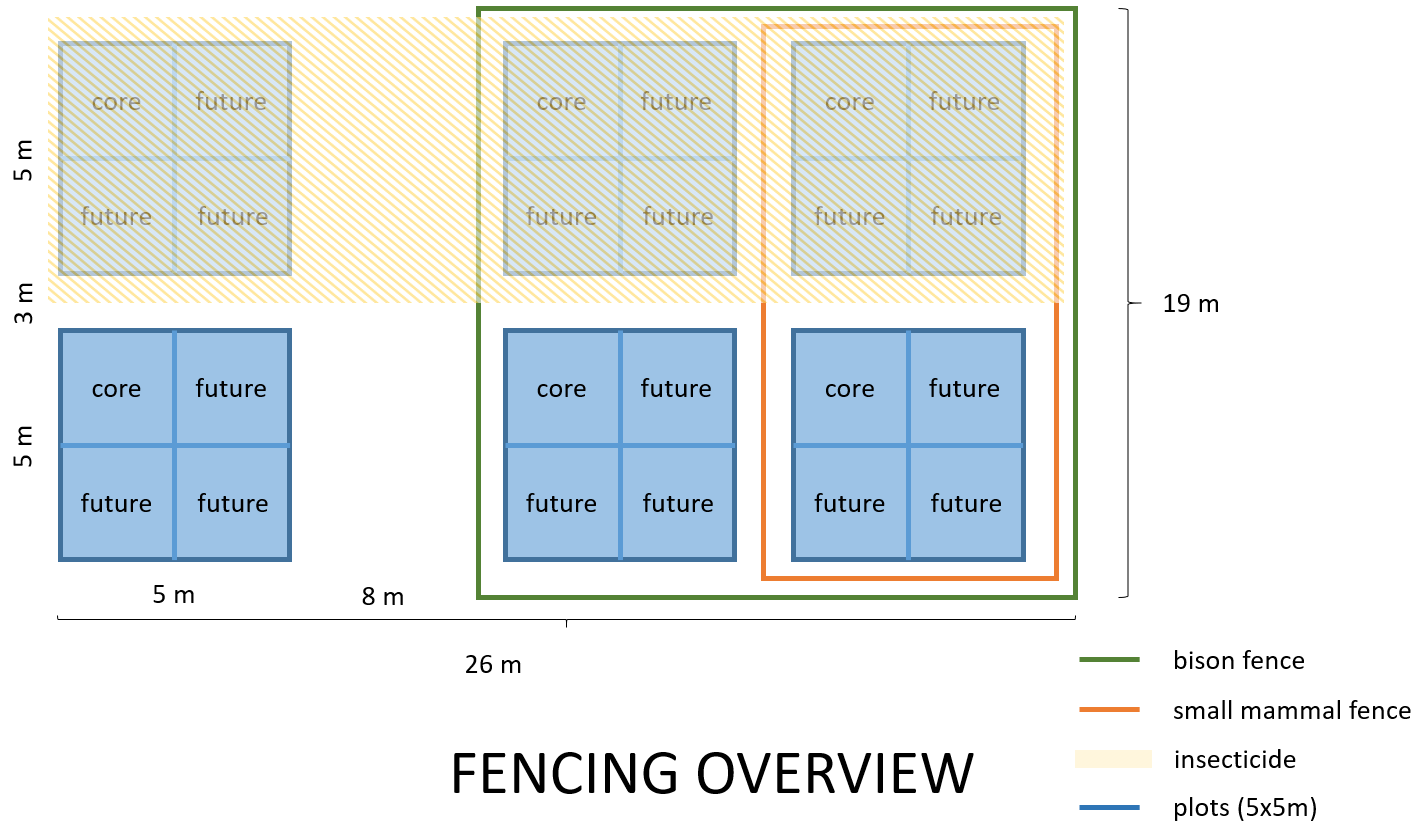We are examining the effects of herbivores of varying size classes on grassland plant community composition and aboveground biomass in the lowlands of Konza Prairie watersheds N1B and N4D. To address the interactive effects of top-down control over grassland communities and fire, the experiment was set up in two adjacent watersheds, one burned annually (N1B) and one burned once every four years (N4D). Plots are 5 x 5 m in area and treatment replicates (N=9) are arrayed in nine blocks within each watershed. Plots within each block are separated by 3 m aisles (with the exception of control plots, which are located 8 m from the fenced plots to prevent trampling effects of bison as they rub on the cattle panels and t-posts), and blocks are located haphazardly throughout the watershed. All plots are permanently marked with conduit. 
Three herbivore removal treatments are applied within the conSME experiment: (1) bison removal; (2) small mammal removal; and (3) insect removal. The small mammal removal treatment is nested within the bison removal treatment, while the insect removal treatment is crossed with all other treatments. Thus, a total of six treatments are applied within each block: (1) control (all herbivores have access), (2) insect removal, (3) bison removal, (4) bison and insect removal, (5) bison and small mammal removal, (6) bison, small mammal, and insect removal.
The bison removal treatment consists of cattle panels surrounding the plots to prevent access by bison, but allowing access by small mammals and insects.
The small mammal removal treatment involves surrounding the entire plot with a ¼” hardware cloth fence. This fence consists of a 1 m high fine mesh, which is buried to a depth of 5” to discourage burrowing under fences. An 8” strip of metal flashing is affixed to the top of the hardware cloth to prevent herbivores from climbing over the fence and into the plots. The small mammal removal treatment excludes all vertebrate herbivores from the plots, but does not prevent access by invertebrate herbivores.
The insect removal treatment is applied by spraying Spectrum triazicide insecticide once every two weeks throughout the growing season on a windless day. In a similar experiment (VIR01), this treatment removes roughly 70% of insects from the plots. An equal quantity of water is added to the insect control plots.
To determine the effects of various herbivore removals on grassland productivity and diversity, plant species composition and end-of-season above-ground biomass are sampled yearly. Pre-treatment data was collected in 2018, and treatments were initiated in 2019. Plant species composition is measured in a permanent 1m2 subunit within each of the experimental plots twice per growing season, once in spring (mid-May to early-June) to determine the abundance of early season forbs and C3 grasses, and once in fall (August) to determine the abundance of late season forbs and C4 grasses. Percent cover is determined for each species to the nearest 1% using a modified Daubenmire method. Two permanent 1m2 subunits within each experimental plot are dedicated to destructive biomass sampling. The aboveground standing crop is sampled once per growing season, at peak biomass (late-August to early-September. One 0.1m2 strip is clipped in each of the two destructive sampling subunit in each plot and the location of strips is moved each year to prevent resampling. Biomass is separated by functional group (graminoid, forb, woody), dried at 60 °C, and weighed.
For additional metadata information see: http://lter.konza.ksu.edu/sites/default/files/DC.pdf
For additional methods information see: http://lter.konza.ksu.edu/sites/default/files/MM.pdf